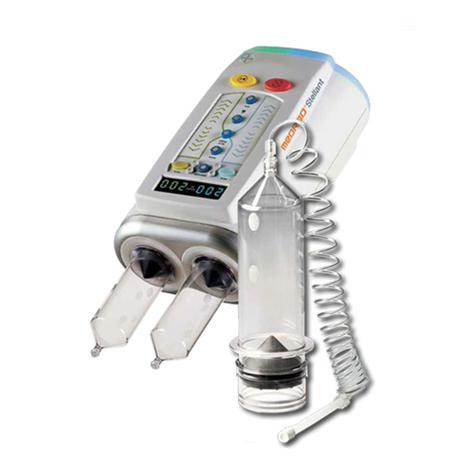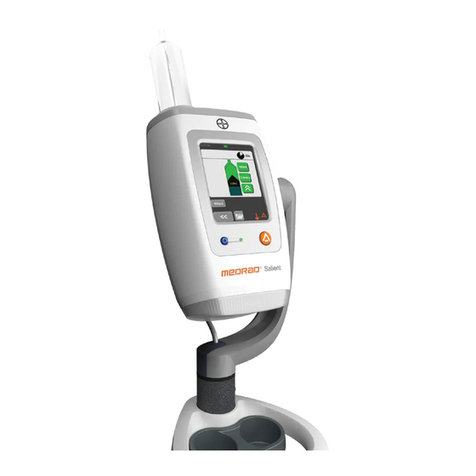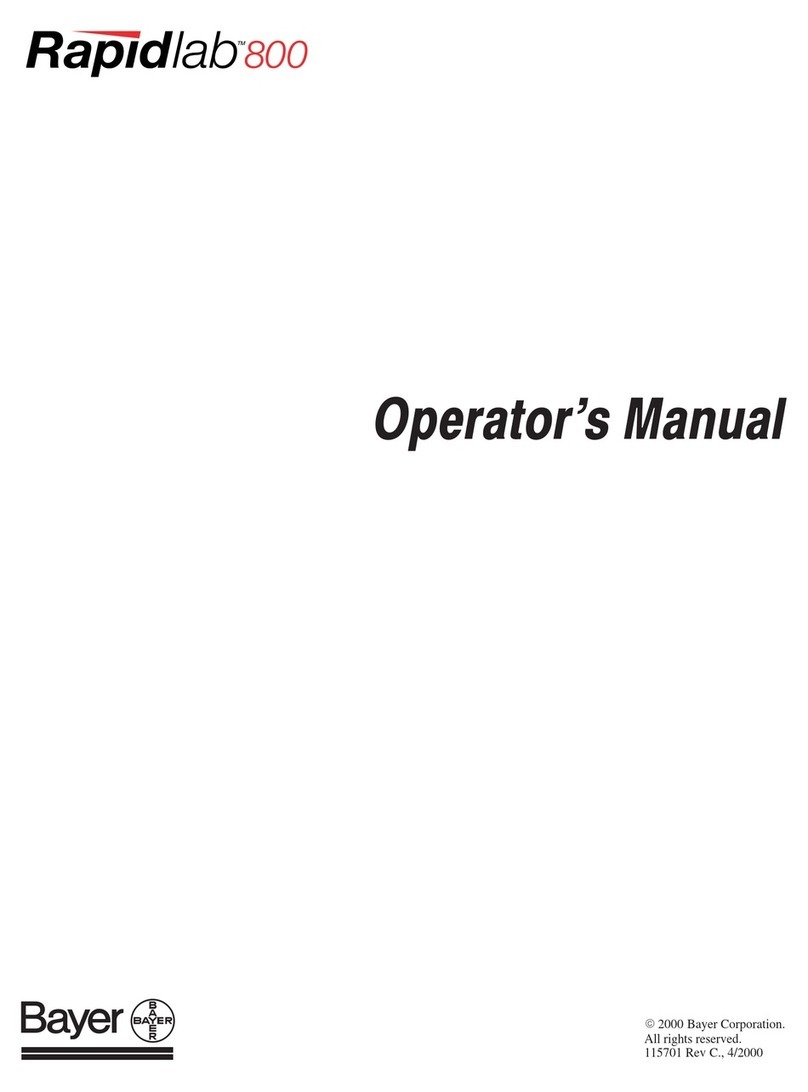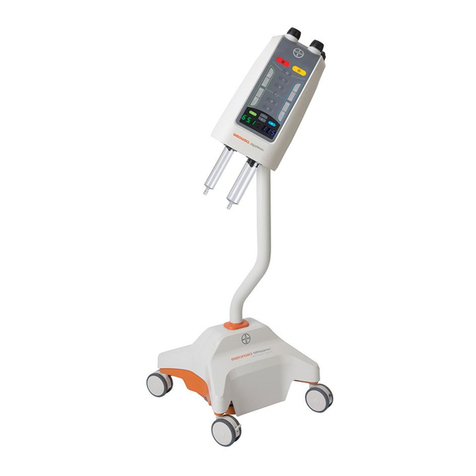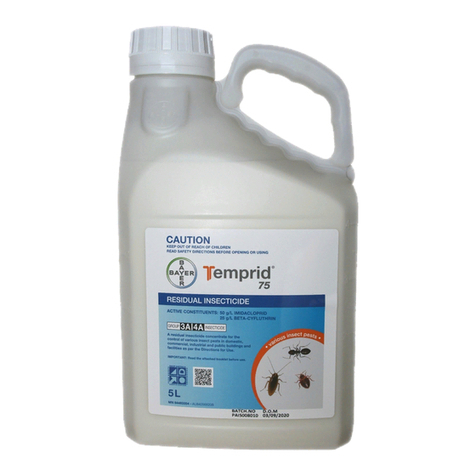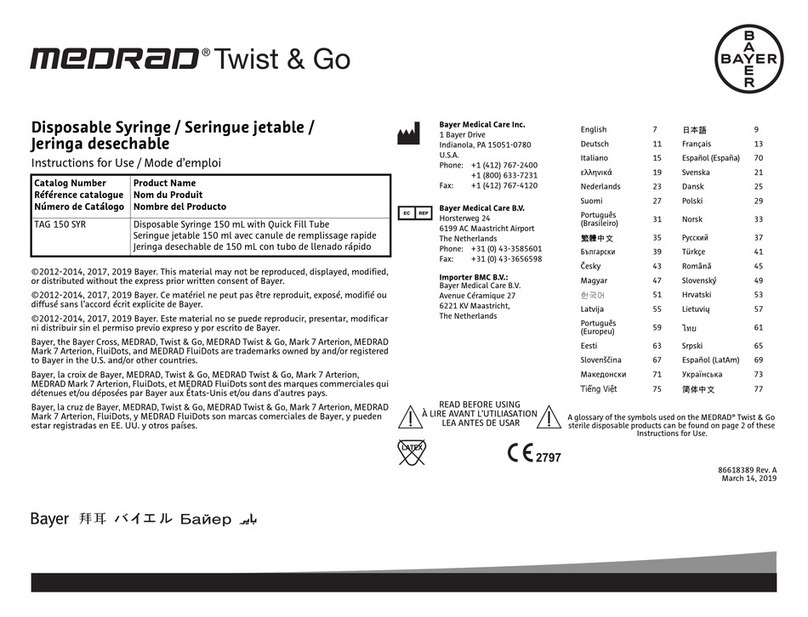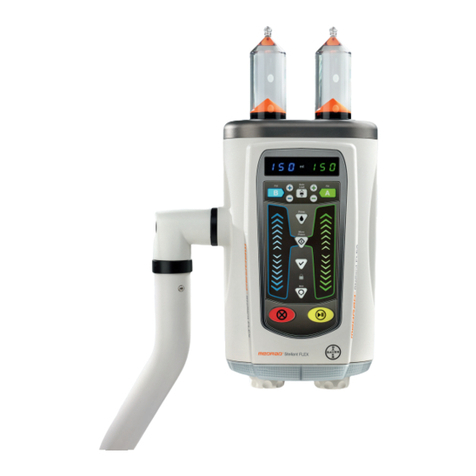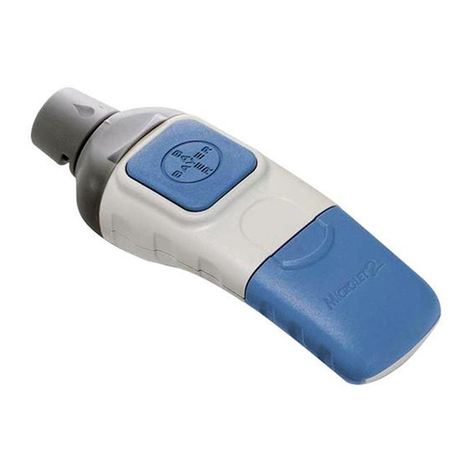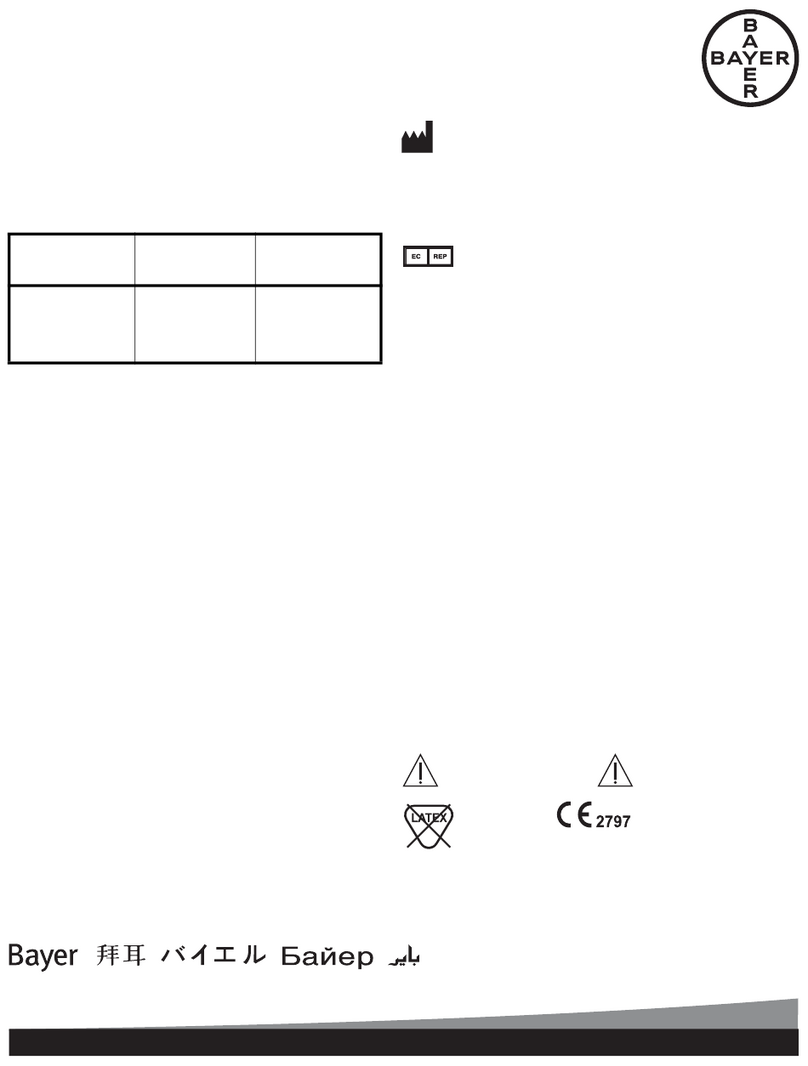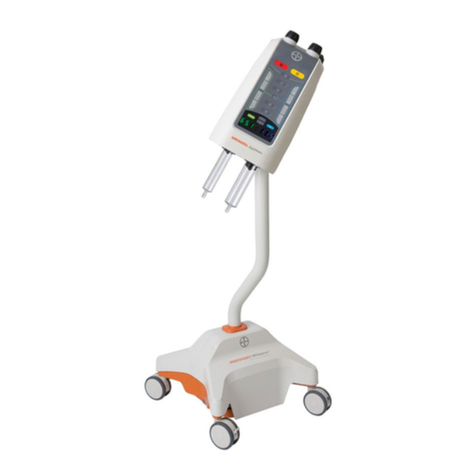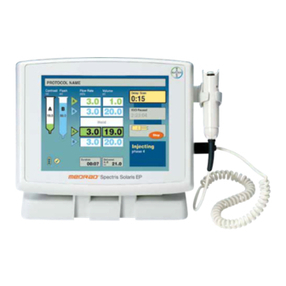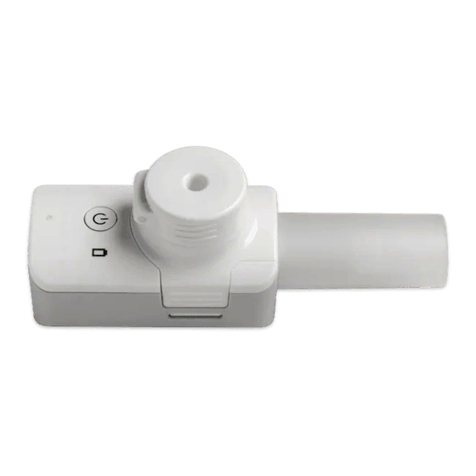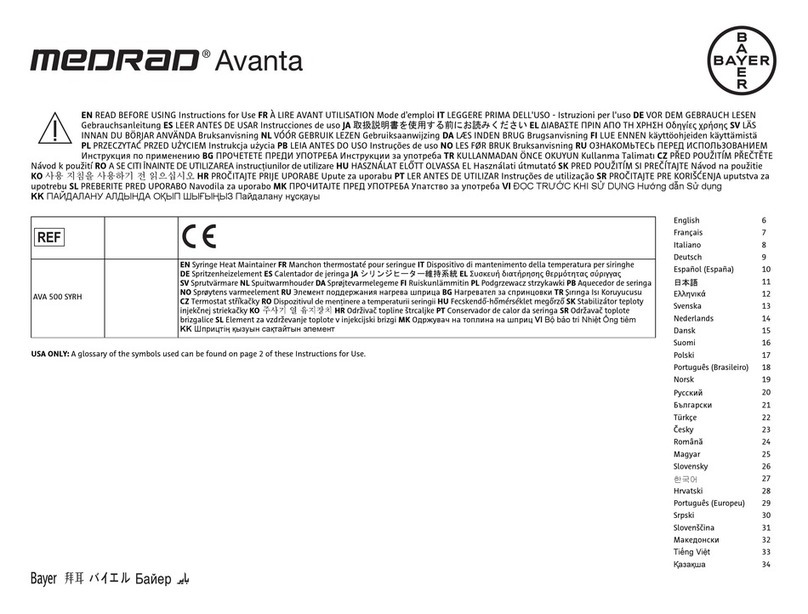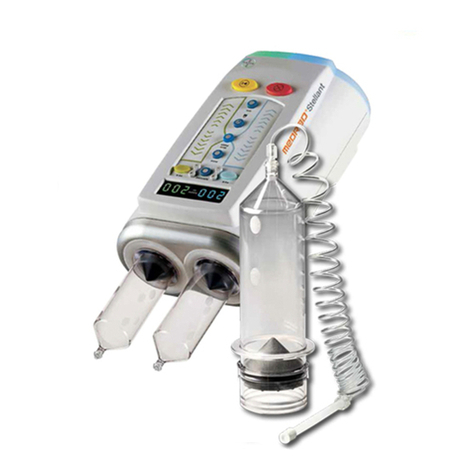
MN090005 Rev B
3/4
English
8. Siga las instrucciones de la sección “Instalación del tubo de
conexión”.
9. Pulse Iniciar.
Nota: no se pueden realizar pruebas de permeabilidad por aspiración
mediante el inyector cuando se usa una válvula de seguridad en el
extremo del tubo conector. Si la aspiración es importante, retire la
válvula de seguridad del tubo conector y conecte directamente el tubo
conector al catéter.
Dispositivo de llenado (punzón): prepare la botella o la bolsa con
el medio de contraste y/o la solución de lavado. Coloque y empuje la
botella o bolsa sobre el dispositivo de llenado hasta que el sello se
perfore.
Desconexión de una jeringa
1. Desconecte el tubo descartable del dispositivo de entrada vascular.
No es necesario desconectar el tubo descartable de la jeringa.
2. Gire la jeringa aproximadamente 1/4 de vuelta en sentido
antihorario y tire con cuidado para desconectarla del cabezal del
inyector; deshágase de la jeringa y del tubo descartable.
Nota: cuando se retira la jeringa del inyector, el pistón se retrae
automáticamente.
Nota: para poder retirar la jeringa, el último movimiento del pistón debe
ser hacia delante, como es normal. Si no puede retirar la jeringa, gire el
control manual del cabezal del inyector aproximadamente una vuelta
hacia delante y repita el paso 2.
Instalación del tubo de conexión
1. Asegúrese de que se haya purgado todo el aire de la jeringa.
2. Extraiga el tubo de conexión del envase. Quite las tapas
protectoras de las conexiones luer Conecte el tubo conector a
la jeringa, haciéndolo girar sólo de 1/4 a 1/2 vuelta. No aplique
demasiada fuerza.
3. Asegúrese de que el accesorio luer del conector esté
correctamente jado a la punta de la jeringa y verique que el
tubo no esté curvado u obstruido.
Si está utilizando un tubo de conexión con un conector en T, acople la
parte recta del conector al medio de contraste (jeringa A) y la extensión
al suero siológico (jeringa B). Si el conector en T
está acoplado a la jeringa B, el tubo de conexión
no se llenará totalmente durante el cebado.
4. Asegúrese de que se haya expulsado todo
el aire.
5. Gire el cabezal del inyector hacia abajo.
6. Conecte el tubo de inyección
al paciente y oprima el botón
Check For Air (Comprobar aire).
AR: Importado y distribuido por Bayer SA, Ricardo Gutiérrez 3652 -
B1605EHD - Munro - Buenos Aires - Argentina, Director Técnico: José
Luis Role, Farmacéutico. Autorizado por la ANMAT N° PM-58-186. Venta
exclusiva a Profesionales e Instituciones Sanitarias.
estén bien rmes, pero no excesivamente apretadas, con el objeto
de evitar fugas, desconexiones y daños a los componentes.
• Consulte el Manual de Operación del sistema inyector para
obtener más información.
NOTA: para reducir al mínimo la formación de burbujas al cargar la
jeringa, no supere un caudal de carga invertida de 7 ml/s.
Instalación de una jeringa
Inserte la jeringa hasta que encaje en su posición. El pistón se acoplará
automáticamente al émbolo y lo hará avanzar hacia la parte delantera
de la jeringa.
Para reducir al mínimo la posibilidad de embolia gaseosa es esencial
la vigilancia y la precaución por parte del operador, así como el
seguimiento de un procedimiento establecido. Mantenga el cabezal del
inyector orientado hacia arriba durante la carga. Mantenga el cabezal
del inyector orientado hacia abajo durante la inyección.
Para contribuir a evitar la inyección de aire, las jeringas de IMAXEON
están equipadas con indicadores FluiDots®. Estos indicadores FluiDots
deben observarse durante el procedimiento de activación. Cuando se
observa un indicador FluiDots a través de una jeringa vacía, los puntos
tienen aspecto de elipses estrechas. Cuando se observan a través de una
jeringa llena, los puntos son más grandes y casi redondos.
Para reducir al mínimo el riesgo de embolia gaseosa, asegúrese de
que solamente un operador sea responsable de llenar las jeringas. No
cambie de operador durante el
procedimiento; si es necesario
cambiarlo, asegúrese de que el
nuevo operador verique que
no haya aire en la trayectoria
del líquido.
Carga y cebado de una jeringa utilizando un tubo de llenado rápido
En el inyector Salient, la jeringa puede cargarse manual o
automáticamente. Consulte el Manual de Operación del sistema Salient
para obtener instrucciones más detalladas.
Carga manual del sistema Salient
1. Coloque una jeringa nueva.
2. Instale el tubo de llenado rápido en el extremo de la jeringa,
haciéndola girar de 1/4 a 1/2 vuelta. No aplique demasiada fuerza.
3. Coloque el tubo de llenado rápido en la fuente de líquido y llene la
jeringa mediante los botones de carga.
4. Expulse el aire.
5. Retire el tubo de llenado rápido. Conecte el tubo desechable.
6. Siga las instrucciones de la sección “Instalación del tubo de
conexión”.
Carga automática del sistema Salient con un punzón o un tubo de
llenado rápido:
1. Seleccione el protocolo y bloquéelo.
2. Coloque una jeringa nueva.
3. Instale el tubo de llenado rápido en el extremo de la jeringa,
haciéndola girar de 1/4 a 1/2 vuelta. No aplique demasiada fuerza.
4. Inserte o el tubo de llenado rápido en la fuente de líquido y pulse
Carga automática.
5. Pulse Llenar.
6. Expulse el aire.
7. Retire el tubo de llenado rápido. Conecte el tubo descartable.
ZY6320: Jeringa de 190 ml con Tubo de Llenado Rápido
ZY6321: Jeringa de 190 ml con Punzón
ZY6322: Jeringa de 190 ml con Tubo de Llenado Rápido
ZY6323: Jeringa de 190 ml con Punzón
ZY6324: Jeringa de 190 ml con Punzón y Tubo Conector Simple de
Baja Presión
ZY6325: Jeringa de 190 ml con Tubo de Llenado Rápido y Tubo
Conector Simple de Baja Presión
ZY5151: Equipo de transferencia en espiral de 300 psi y 150 cm
ZY5152: Equipo de transferencia en espiral de 300 psi y 150 cm, con
conector en T
Introducción:Lea la información contenida en esta sección. Entender la
información le ayudará a utilizar el dispositivo de forma segura.
Aviso de seguridad importante: este dispositivo está diseñado para ser
usado por personas con capacitación adecuada y experiencia en estudios
de diagnósticos por imagen.
Uso previsto: el contenido de este equipo se utiliza para la infusión de
medios de contraste o suero siológico. Está indicado para un solo uso
en un solo paciente, con los inyectores Salient. Para más información,
consulte las instrucciones del fabricante del medio de contraste.
Contraindicaciones: estos dispositivos no deben utilizarse con varios
pacientes, para infusión de fármacos, en quimioterapia, ni para un uso
que no sea el indicado.
Venta restringida: sólo por prescripción médica.
Advertencias
• Una embolia gaseosa puede provocar la muerte o graves
lesiones al paciente. No conecte el inyector al paciente hasta
haber eliminado todo el aire de la jeringa y de la trayectoria del
líquido. Lea atentamente las instrucciones sobre la carga y uso de
los indicadores FluiDots® (si corresponde) para reducir el riesgo de
embolia gaseosa.
• El uso repetido de artículos descartables o la no aplicación de
técnicas asépticas puede provocar contaminación biológica.
Deshágase correctamente de los artículos descartables después de
su uso o si sospecha que haya podido producirse contaminación.
• La extracción del émbolo pondrá en peligro la esterilidad de la
jeringa, pudiendo causar infecciones al paciente. No extraiga el
émbolo para llenar la jeringa.
• Puede producirse contaminación bacteriana si se utilizan las
jeringas para almacenar medios de contraste. Una vez cargadas
las jeringas, úselas de inmediato. Deseche las jeringas cargadas que
no hayan sido utilizadas.
• El uso de componentes dañados o procedentes de un
envase abierto o dañado puede causar lesiones al paciente
o al operador. Inspeccione visualmente el envase y todos los
componentes antes de su uso.
• La fuga de medio de contraste o la rotura del tubo puede causar
lesiones al paciente o al operador. Asegúrese de que la trayectoria
del líquido no esté obstruida y que las presiones no superen los
límites indicados en la etiqueta del envase. El uso de presiones
superiores o una oclusión en la trayectoria del líquido puede
provocar fugas o roturas.
• Un acoplamiento incorrecto de la jeringa puede causar lesiones
al paciente. No cargue la jeringa ni la use para inyectar a menos
que esté correctamente acoplada
Precauciones
• Los componentes pueden sufrir daños o fugas si no se los
instala correctamente. Asegúrese de que todas las conexiones
Español
Jeringa vacía Jeringa llena
Hecho para:
Imaxeon Pty Ltd
Unit 1, 38-46 South St
Rydalmere 2116
NSW Australia
Hecho por:
Vincent Medical (Dong Guan) Mfg. Co., Ltd.
45-46 ShaBu Industrial Zone
Qiao Long District
Tang Xia Town, Dong Guan City
Guangdong, China 523730
set, do not exceed a reverse load rate of 7 ml/sec.
Installing a Syringe
Insert the syringe until it snaps into place. The piston automatically
engages the plunger, and advances it to the front of the syringe.
Operator vigilance and care, coupled with a set procedure, is essential
to minimizing the possibility of an air embolism. Point the injector
head up during loading. Point the injector head down during an
injection.
To help avoid an air injection, IMAXEON syringes are equipped with
FluiDots® indicators. MEDRAD®
FluiDots indicators should be
observed as part of an arming
procedure. When the MEDRAD®
FluiDots are viewed through
an empty syringe, the dots ap-
pear as small narrow ellipses.
When viewed through a full syringe, the dots become larger, almost
round.
To minimize air embolization risks, ensure that one operator is
designated the responsibility of lling the syringe(s). Do not change
operators during the procedure. If an operator change must occur,
ensure that the new operator veries that the uid path is purged of
air.
Loading and Priming a Syringe Using a Quick Fill Tube (QFT)
The syringe can be loaded manually or automatically on the Salient
injector. See the MEDRAD® Salient” Operation Manual for more detailed
instructions.
Salient Manual Loading:
1. Install a new syringe.
2. Install the QFT onto the end of the syringe, 1/4 turn to 1/2 turn
maximum. Do not install with excessive force.
3. Insert the QFT into the uid source and ll the syringe with uid,
using the load buttons.
4. Expel air.
5. Remove QFT. Connect the disposable tubing set.
6. Follow the instructions in the section “Connector Tube
Installation.”
Salient Integral Autoload with a QFT:
1. Install a new syringe.
2. Select the syringe on the ll screen and press the “Auto” Fill tab
3. Install a QFT onto the end of the syringe, 1/4 turn to 1/2 turn
maximum. Do not install with excessive force.
4. Insert the QFT into the uid source and press the start button on
the “Auto” Fill tab.
5. Expel air.
6. Remove QFT. Connect the disposable tubing set.
7. Follow the instructions in the section “Connector Tube
Installation.”
8. Press Next button to set the injection parameters
NOTE: Patency check through aspiration using the injector is not
possible when using a check valve on the end of the connector tube.
If aspiration is important, remove the check valve from the connector
tube and directly connect the connector tube to the catheter.
Filling with Spike
Prepare the bottle or bag of contrast and/or ushing solution. Push the
bottle or bag onto the spike until the seal is punctured.
Removing a Syringe(s)
1. Disconnect the disposable tubing set from the vascular entry
device. The disposable tubing set does not need to be disconnected
from the syringe.
2. Rotate the syringe approximately 1/4 turn counter-clockwise and
gently pull the syringe out of the injector head, discarding the
syringe with disposable tubing set.
NOTE: Once the syringe is removed from the injector, the piston will
automatically retract.
NOTE: In order to remove the syringe, the last piston motion must be
in the forward direction, which is typical. If you cannot remove the
syringe, press the “Back” button until the ll screen is displayed, press
the retract button, then repeat Step 2.
Connector Tube Installation
1. Ensure all air is purged from the syringe.
2. Remove the connector tube from the package. Remove the
dust covers on the luer ttings. Attach the connector tube to
the syringe, 1/4 turn to 1/2 turn maximum. Do not install with
excessive force.
3. Ensure that the connector luer tting is secured to the tip of the
syringe and verify that the tubing is not kinked or obstructed.
If you are using a connector tube with T-connector, attach the straight
portion of the T-connector to the contrast (Syringe
A) and the extension to the saline (Syringe B). If the
T-connector is connected to Syringe B, priming will
not completely ll the connector tubing.
4. Ensure all air is purged.
5. Rotate the injector head downward.
6. Connect to the patient and press ARM.
7. The injector will ask for CHECK FOR AIR.
Introduction:
Read the information contained in this section. Understanding the
information will assist you in operating the device in a safe manner.
Important Safety Notice: This device is intended to be used by
individuals with adequate training and experience in diagnostic
imaging studies.
Intended Use: The contents of this package are intended to be used in
the delivery of contrast media or saline. They are indicated for single-
use on one patient only with MEDRAD® Salient and MEDRAD® Vistron
Plus Injectors. The transfer set is intended for use for one container
of media only, and must be discarded when the container becomes
empty, or after six hours, whichever comes rst. Refer to the media
manufacturer’s instructions for use for additional indications.
Contraindications: These devices are not intended for multiple patient
use, drug infusion, chemotherapy, or any other use for which the device
is not indicated.
Restricted Sale: Rx Only
Warnings
• Air embolization can cause death or serious injury to the
patient. Do not connect a patient to the injector until all trapped
air has been cleared from the syringe and uid path. Carefully
read the instructions for loading and the use of MEDRAD® FluiDots
indicators to reduce the chance of air embolism.
• Biological contamination can result from reusing disposable
items or failure to follow aseptic technique. Properly discard
disposable items after use, or if there is any possibility that
contamination may have occurred.
• Syringe sterility will be compromised, and patient infection
may result, if the plunger is removed from the syringe. Do not
remove the plunger to ll the syringe.
• Bacterial contamination can occur if syringes are used to
store contrast media. Use loaded syringes immediately. Discard
unused loaded syringes.
• Patient or operator injury may result if package is opened or
damaged, or if damaged components are used. Visually inspect
contents and package before each use.
• Patient or operator injury may result from contrast media
leaks or tubing ruptures. Ensure that the uid path is open; do
not exceed pressures identied on the front of the package. Use
of greater pressures or occlusions in the uid path may result in
leaks or ruptures.
• Patient injury could result if syringe is not properly engaged.
Do not load or inject unless the syringe is properly engaged.
Cautions
• Component damage or leaks may occur if not installed properly.
Ensure all connections are secure; do not overtighten. This will
help minimize leaks, disconnection, and component damage.
• Refer to the Injector Operation Manual for further instructions.
NOTE: To minimize bubbles when loading a syringe through a transfer
Empty Filled

